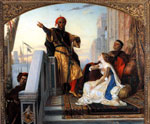From the collection of:
The Speed Art Museum || VAM Home
Alexandre Cabanel (French, 1823-1899)
OTHELLO RELATING HIS ADVENTURES, 1857
Oil on canvas; 45-1/2" X 51-1/2"
Museum Purchase, 72.36
The Speed Art Museum
A narrative work of art is one that tells a story. Alexandre Cabanel used one of William Shakespeare’s most popular plays as the basis for this narrative painting. It depicts Othello the Moor sharing his heroic tales from the time he spent serving in the Venetian armed forces with wife-to-be Desdemona and her father. Meanwhile, the villainous Iago listens furtively. The passionate subject matter and dramatic artistic details that Cabanel has used to enrich the scene would have appealed to the Romantic tastes of the period in which the painting was created.
To set the mood of the story, Cabanel’s scene depicts the Italian city of Venice as clouds literally gather on the horizon. Othello describes his exploits as Desdemona and her father listen intently. Othello’s dramatic gesture emphasizes his strength and is in strong contrast to the soft, light shape of Desdemona. The evil Iago is listening from the gathering shadows. In Shakespeare’s play Othello, it is revealed that Othello has denied Iago a promotion in the army, and Iago wants revenge. Iago deceives Othello into believing that his beloved Desdemona has been unfaithful. Enraged, Othello kills Desdemona. When Othello then learns that his wife was faithful to him after all, he kills himself in remorse.
The painter enriched the scene by clothing the characters in dramatic costumes and even added an exotic flair by placing an Oriental rug on the floor of the porch. If that weren’t enough to play up the theatrics of the composition, the scene takes place within a gilded frame whose very design echoes the shape of a stage.
Romanticism was a late 18th- and early 19th-century movement that emphasized the values of passionate emotion and artistic freedom. The Romantic philosophy glorified emotion, imagination, mystery, and the pursuit of one’s unique destiny. Romantics had a deep fascination with historical literature and artistic styles that stood in contrast to a world that was becoming increasingly industrialized and developed.
About the Artist
Alexandre Cabanel was born in Montpellier, France, into a family with very little means. At the age of 11, the boy was awarded a grant that allowed him to study at the Ecole des Beaux-Arts in Paris. Cabanel entered his first Salon show at the age of 20 and won second place in the Prix de Rome at 22. Though a successful artist, he was best known during his lifetime as a teacher of the academic arts.
Classroom Ideas
Discussion: Do a visual inventory of the artwork. Describe what you see in the painting and speculate on the individual characters and the overall “plot” depicted in the scene. Then consider this painting apart from its connections with Shakespeare’s famous play. What do you think about it? Does knowing the story of Othello enhance your enjoyment of the painting, or do you prefer to imagine your own tale? How does Cabanel use the elements of art to tell us about each of the characters?
Activity: Think of a story from real life, a movie or book, or your imagination. What could you tell someone about the story with just one picture? Using your medium of choice, paint or draw a moment or scene from the story. Have classmates guess what the story is about when you’ve finished.
Links
Find articles about and images by Alexandre Cabanel in the Artcyclopedia.
[www.artcyclopedia.com/artists/cabanel_alexandre.html]
Learn more about the Ecole des Beaux-Arts and the Prix de Rome at Bartleby’s.
[www.bartleby.com/65/ec/Ecoledes.html]

